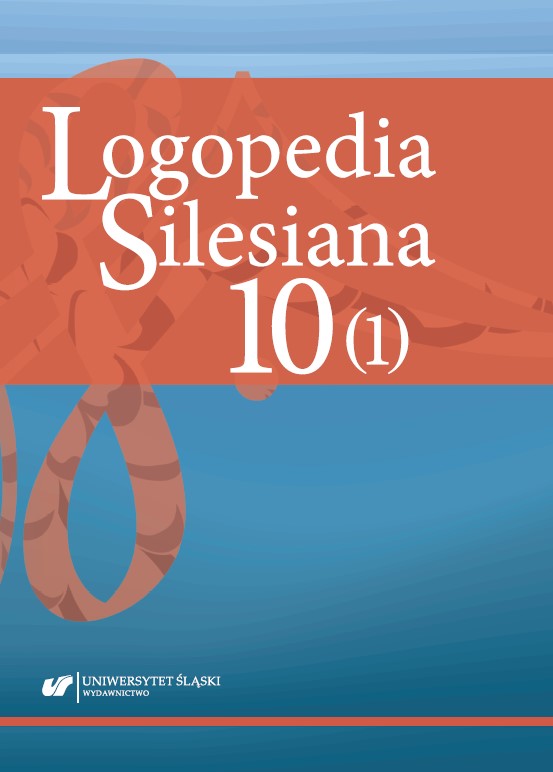Fiszer, M., Kotyło, P., Niebudek-Bogusz, E., Merecz, D., Śliwińska-Kowalska, M. (2002).
Google Scholar
Ocena zaburzeń głosu i problemów psychologicznych u nauczycieli. Otorynolaryngologia, 1(3), 181–186.
Google Scholar
Guzy, A. (2014). Jakość emisji głosu przyszłych nauczycieli. W: D. Krzyżyk, B. Niesporek-Szamburska (red.), Językowe, literackie i kulturowe ścieżki edukacji polonistycznej (tradycja i współczesność). Księga jubileuszowa dedykowana Profesor Helenie Synowiec w czterdziestolecie pracy naukowej i dydaktycznej (s. 427–440). Katowice: Wydawnictwo Uniwersytetu Śląskiego.
Google Scholar
Kazanecka, A., Niebudek-Bogusz, E., (2009). Porównanie wyników wskaźnika niepełnosprawności głosowej VHI w grupie nauczycieli z zaburzeniami głosu oraz w grupie osób z dysfonią o podłożu pozazawodowym. Medycyna Pracy, 60(4), 283–288.
Google Scholar
Laskowska, H. (2006). Wykorzystanie emisji głosu mówionego w edukacji. W: L. Kataryńczyk-Mania, I. Kowalkowska (red.), Profilaktyka i rehabilitacja głosu, mowy (s. 33–37). Zielona Góra: Oficyna Wydawnicza Uniwersytetu Zielonogórskiego.
Google Scholar
Niebudek-Bogusz, E., Kuzańska, A., Woźnicka, E., Śliwińska-Kowalska, M. (2007). Ocena zaburzeń głosu u nauczycieli za pomocą wskaźnika niepełnosprawności głosowej (voice Handicap Index – VHI). Medycyna Pracy, 58(5), 393–402.
Google Scholar
Ratajczak, J., Rapiejko, P., Jurkiewicz, D. (2007). Wpływ wykonywanego zawodu na samoocenę zaburzeń głosu. Otolaryngologia Polska, 61(5), 857–863.
Google Scholar
Rosłaniec, A., Sielska-Badurek, E., Niemczyk, K. (2019). Ocena przestrzegania zasad higieny i emisji głosu przez nauczycieli. Polski Przegląd Otorynolaryngologiczny, 2019, 8(2), 18–24.
Google Scholar
Sambor, B. (2017). Fizjologia i anatomia układu oddechowo-fonacyjno-artykulacyjnego jako podstawa planowania terapii głosu. W: D. Pluta-Wojciechowska, B. Sambor (red.), Współczesne tendencje w diagnozie i terapii logopedycznej (s. 339–360). Gdańsk: Harmonia Universalis.
Google Scholar
Sznurowska-Przygocka, B., Śliwińska-Kowalska, M. (2012). Ocena skuteczności rehabilitacji foniatrycznej głosu u nauczycieli z przewlekłą dysfonią. Otorynolaryngologia, 11(2), 60–70.
Google Scholar
Śliwińska-Kowalska, M., et al. (2003). Ocena skuteczności terapii głosowej w leczeniu zaburzeń głosu u nauczycieli. Medycyna Pracy, 54(4), 319–325.
Google Scholar
Śliwińska-Kowalska, M., Niebudek-Bogusz, E. (2009). Rehabilitacja zawodowych zaburzeń głosu. Poradnik dla nauczycieli. Łódź: Instytut Medycyny Pracy im. prof. J. Nofera.
Google Scholar
Tarasiewicz, B. (2019). Mówię i śpiewam świadomie. Podręcznik do nauki emisji głosu. Kraków: Universitas.
Google Scholar
Van Houtte, E., Claeys, S., Wuyts, F., Van Lierde, K. (2011). The impact of voice disorders among teachers: Vocal complaints, treatment-seeking behavior, knowledge of vocal care, and voice-related absenteeism. Journal of Voice, 25(5), 570–575.
Google Scholar
Verdolini, K., Ramig, L. (2001). Review: Occupational risks for voice problems. Logopedics Phoniatrics Vocology, 26(1), 37–46.
Google Scholar


 https://doi.org/10.31261/LOGOPEDIASILESIANA.2021.10.01.04
https://doi.org/10.31261/LOGOPEDIASILESIANA.2021.10.01.04

 10.31261/LOGOPEDIASILESIANA
10.31261/LOGOPEDIASILESIANA